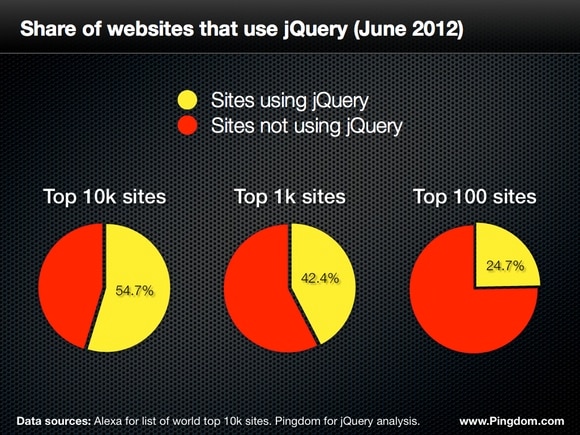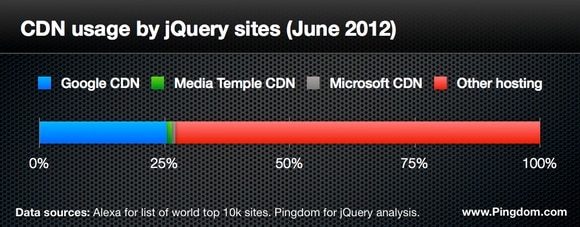
We’re big fans of the JavaScript library jQuery, and it appears we are far from alone. As of June this year it’s used by 54.7% of the top 10,000 websites in the world. That’s a massive endorsement by the world’s web developers. It’s also a significant step forward from two years ago, when 28% of the sites used jQuery.
This kind of widespread adoption is rare for JavaScript libraries, perhaps unprecedented. And jQuery hasn’t been around all that long; John Resig released the first version in 2006. It’s clearly another win for the use of open source software on the Web. Even Microsoft has embraced jQuery and is one of its supporters.
Analyzing jQuery usage among the top sites
While we did the research for this post, we also looked at how popular jQuery is among the top 1,000 and top 100 websites in the world, to give some added perspective.

Want a bigger chart? Here it is.
The jQuery usage among the top 100 sites would probably be a bit higher if Google weren’t behind such a big portion of them. Google owns one in five of the top 100 sites, and those sites don’t use jQuery. This in all likelihood skews the number a bit.
Big sites that use jQuery
There are literally thousands of big sites that use jQuery, but a few examples are in order. So, here is a selection of some of the world’s biggest sites, all using jQuery:
WordPress.com, Pinterest, Reddit, MSN.com, WordPress.org, Amazon, Yandex, Microsoft.com, GO.com, Ask.com, ESPN, Craigslist, About.com, Go Daddy, Stack Overflow, Huffington Post, Instagram, Slideshare, Fox News, The Guardian, Etsy, LiveJournal, Weather.com and many, many more.
The most popular CDN for jQuery
Both Google, Microsoft and Media Temple have generously provided CDNs (content delivery networks) that site owners can freely use when they include jQuery on their sites. Site owners can of course elect to host the script(s) themselves as well.
So which jQuery hosting option is the most popular? Some additional analysis gave us the following result.

Larger version available here.
It should be mentioned that there is a certain amount of overlap in CDN usage. Almost half of the sites that use Microsoft’s CDN also use Google’s, for example.
It appears that the Google Ajax API CDN is by far the most popular CDN among web developers. A full 25.4% of sites that use jQuery include the script from Google’s CDN.
The other two CDNs listed on jQuery’s site don’t even come close. There are 35 times as many sites using Google’s CDN as Microsoft’s. Media Temple’s jQuery CDN doesn’t fare much better; 23 times as many sites use Google’s CDN. Google’s dominance is quite complete here.
That said, the majority of the sites with jQuery don’t use any of these three CDNs. Either they are using a different CDN, or host it themselves (the latter being more likely for most sites).
Conclusion
JQuery is in excellent health. It has powerful backers and contributors and a lively developer community. The popularity of jQuery has kept growing over the years, and deservedly so. We are proud to be one of the project sponsors.
We hope to revisit this post a year or so from now. Where do you think jQuery adoption will be by then? Judging by these numbers, it certainly isn’t likely to go down anytime soon.
Methodology: We downloaded the HTML code for the top 10k websites in the world, according to Alexa (on June 19, 2012), and scanned for any variation of jQuery script inclusion. We only tested the homepages, i.e. the initial page you get when you visit a site.
























